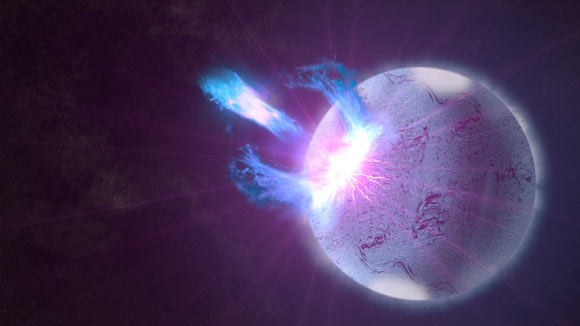Now Reading: Magnetar Flares Linked to Gold and Heavy Element Formation
-
01
Magnetar Flares Linked to Gold and Heavy Element Formation
Magnetar Flares Linked to Gold and Heavy Element Formation

Quick Summary
- Astronomers have discovered that magnetar flares, highly magnetized neutron stars, can produce up to 10% of heavy elements like gold and platinum in the Milky Way.
- Magnetars are remnants of supernovae with intense magnetic fields and nearly black-hole-like density.
- Heavy elements form via the r-process (or rapid-neutron capture process), which requires unique nuclear reaction conditions.
- Previous evidence from a 2017 neutron star collision confirmed some heavy-element formation but suggested additional mechanisms might be required.
- Researchers used archival data from a magnetar flare (SGR 1806-20) to validate theories on their role in ejecting r-process elements into space.
- Findings match predictions on the timing and energy levels released by magnetar flares during element creation through radioactive decay processes.
- These insights mark only the second direct observation of how heavy elements such as gold are formed in extreme cosmic events.
- Columbia university’s study is published in Astrophysical Journal Letters.

Image credit: NASA’s Goddard Space Flight Center / S. Wiessinger.
Indian Opinion Analysis
This groundbreaking study provides valuable answers to long-standing questions about cosmic element formation and may expand scientific understanding globally,including for Indian astrophysical research communities actively contributing to space exploration. India’s growing expertise in astrophysics, exemplified by projects like ISRO’s AstroSat mission, could benefit from integrating such discoveries into its long-term strategies for space science innovation.
The implications stretch beyond academia-precious metals central to technology development (like those found in electronics) originate from rare celestial events spanning billions of years and unimaginable forces.This realization underscores humanity’s interconnectedness with the cosmos and calls for deeper investments in public-funded science programs worldwide.
For India specifically, fostering collaboration between domestic institutions like TIFR (tata Institute of Basic Research) or IUCAA (Inter-University Centre for Astronomy & Astrophysics) with global teams could strengthen knowledge sharing while elevating local scientific infrastructure-a pivotal step toward larger aspirations within international astrophysics initiatives.




























